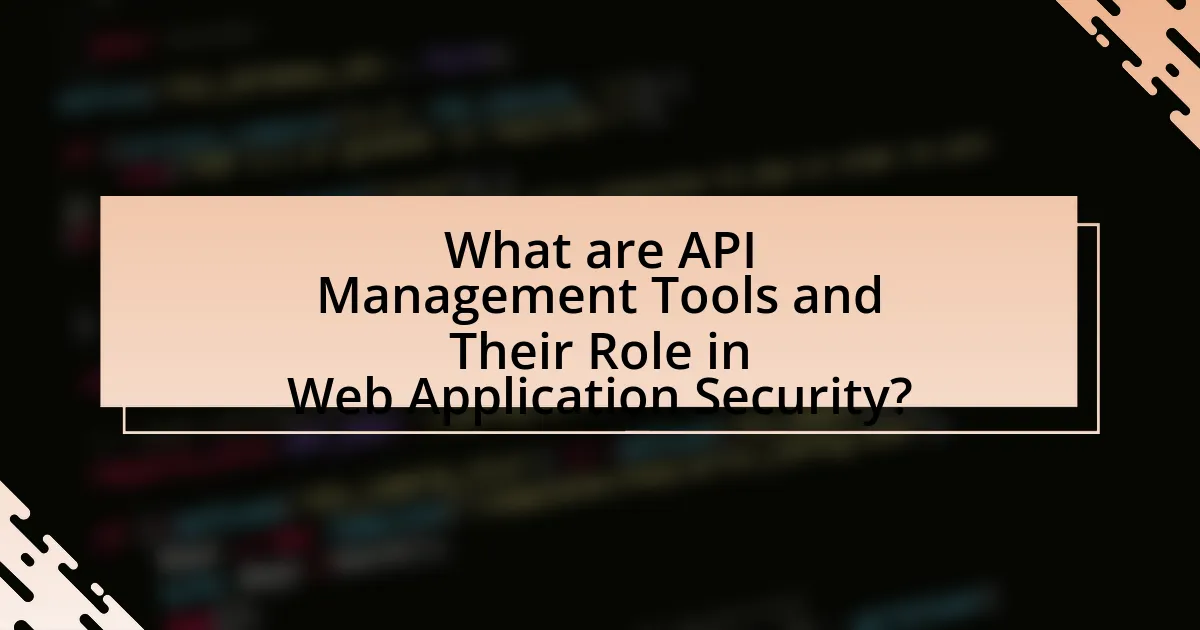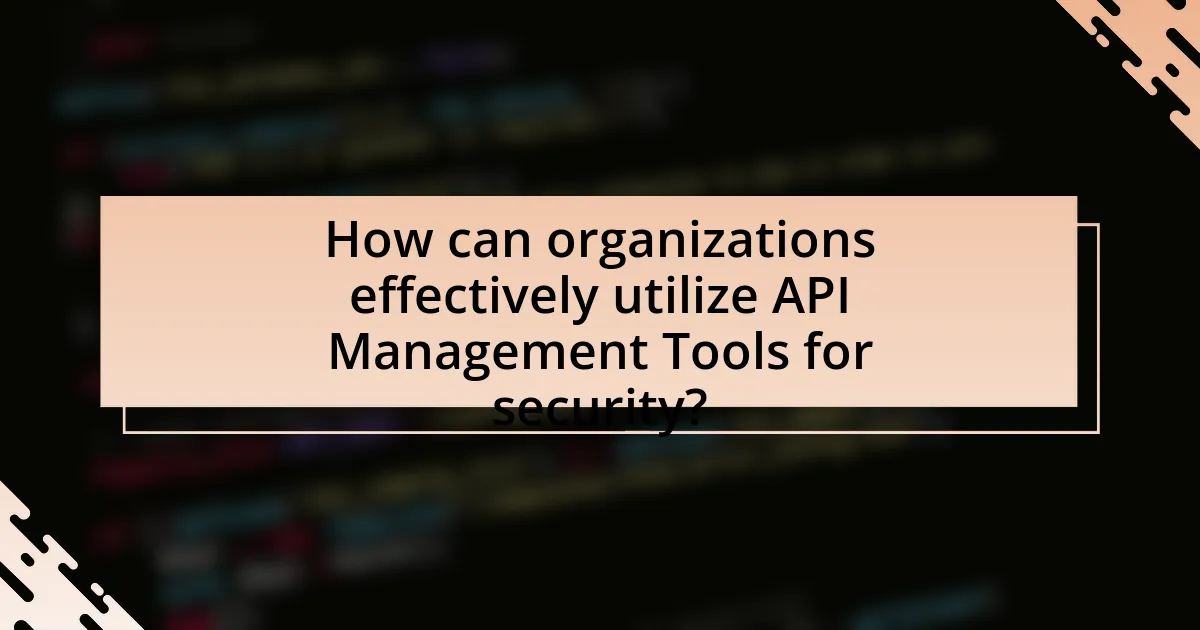API management tools are essential software solutions that enhance web application security by facilitating the creation, deployment, and monitoring of application programming interfaces (APIs). These tools provide critical features such as authentication, authorization, encryption, and traffic management, which collectively protect APIs from unauthorized access and abuse. The article explores how API management tools function to enhance security, the key features that contribute to this security, and the integration of these tools with existing web applications. Additionally, it addresses the importance of API security, common threats faced by web applications, and best practices for organizations to effectively utilize API management tools to mitigate risks and ensure compliance with security standards.
What are API Management Tools and Their Role in Web Application Security?

API management tools are software solutions that facilitate the creation, deployment, and monitoring of application programming interfaces (APIs), playing a crucial role in web application security. These tools provide features such as authentication, rate limiting, and traffic monitoring, which help protect APIs from unauthorized access and abuse. For instance, according to a report by Gartner, organizations that implement API management solutions can reduce security vulnerabilities by up to 50% due to enhanced monitoring and control mechanisms. Additionally, API management tools often include encryption and data masking capabilities, further safeguarding sensitive information transmitted through APIs.
How do API Management Tools function to enhance security?
API Management Tools enhance security by providing features such as authentication, authorization, and traffic management. These tools enforce security protocols like OAuth and API keys to ensure that only authorized users can access sensitive data. Additionally, they monitor API traffic for anomalies, helping to detect and mitigate potential threats in real-time. By implementing rate limiting and throttling, API Management Tools prevent abuse and denial-of-service attacks, further securing the application. The integration of logging and analytics allows for detailed tracking of API usage, which aids in identifying security breaches and compliance with regulations.
What are the key features of API Management Tools that contribute to security?
API Management Tools enhance security through several key features, including authentication, authorization, encryption, and rate limiting. Authentication ensures that only verified users can access APIs, often utilizing OAuth or API keys to validate identities. Authorization controls what authenticated users can do, ensuring they have the appropriate permissions for specific actions. Encryption protects data in transit and at rest, safeguarding sensitive information from unauthorized access. Rate limiting prevents abuse by controlling the number of requests a user can make in a given timeframe, mitigating the risk of denial-of-service attacks. These features collectively strengthen the security posture of web applications by ensuring that only legitimate traffic is allowed and that sensitive data remains protected.
How do these tools integrate with existing web applications?
API management tools integrate with existing web applications by providing a layer that facilitates communication between the application and external services. These tools typically utilize RESTful APIs or GraphQL to connect seamlessly, allowing for secure data exchange and enhanced functionality. For instance, API gateways can enforce security policies, manage traffic, and monitor usage, which directly contributes to the overall security posture of the web application. According to a report by Gartner, organizations that implement API management solutions can reduce security vulnerabilities by up to 30%, demonstrating the effectiveness of these tools in enhancing web application security.
Why is API security critical for web applications?
API security is critical for web applications because it protects sensitive data and ensures the integrity of the application. APIs serve as gateways for data exchange between different systems, making them prime targets for cyberattacks. According to the 2021 API Security Report by Salt Security, 95% of organizations experienced an API security incident in the past year, highlighting the prevalence of vulnerabilities. Securing APIs helps prevent unauthorized access, data breaches, and service disruptions, which can lead to significant financial and reputational damage for businesses.
What are the common security threats faced by web applications?
Common security threats faced by web applications include SQL injection, cross-site scripting (XSS), cross-site request forgery (CSRF), and security misconfigurations. SQL injection allows attackers to manipulate database queries, potentially exposing sensitive data. XSS enables the injection of malicious scripts into web pages viewed by users, compromising their data. CSRF tricks users into executing unwanted actions on a web application where they are authenticated, leading to unauthorized transactions. Security misconfigurations occur when applications are not securely set up, leaving them vulnerable to attacks. According to the OWASP Top Ten, these threats are prevalent and can significantly impact the security posture of web applications.
How do APIs serve as potential vulnerabilities in web applications?
APIs serve as potential vulnerabilities in web applications primarily due to inadequate authentication and authorization mechanisms. When APIs lack robust security measures, they can be exploited by attackers to gain unauthorized access to sensitive data or functionalities. For instance, a study by the Open Web Application Security Project (OWASP) highlights that broken authentication is one of the top vulnerabilities, allowing attackers to impersonate legitimate users and manipulate data. Additionally, poorly designed APIs may expose endpoints that are not properly secured, leading to data leakage or injection attacks. These vulnerabilities underscore the necessity for comprehensive API management tools that enforce security protocols and monitor API traffic to mitigate risks effectively.
What specific security enhancements do API Management Tools provide?

API Management Tools provide specific security enhancements such as authentication, authorization, encryption, and threat protection. These tools implement OAuth and API keys for authentication, ensuring that only authorized users can access the APIs. They also enforce role-based access control (RBAC) to manage permissions effectively. Encryption is utilized to protect data in transit and at rest, safeguarding sensitive information from unauthorized access. Additionally, API Management Tools incorporate threat detection mechanisms, such as rate limiting and IP whitelisting, to mitigate risks from malicious attacks and abuse. These enhancements collectively strengthen the security posture of web applications by controlling access, protecting data, and preventing attacks.
How do API Management Tools implement authentication and authorization?
API Management Tools implement authentication and authorization primarily through mechanisms such as OAuth, API keys, and JSON Web Tokens (JWT). These tools enforce security policies by validating user credentials and permissions before granting access to APIs. For instance, OAuth allows third-party applications to access user data without sharing passwords, while API keys serve as unique identifiers for applications, ensuring that only authorized users can interact with the API. Additionally, JWTs enable secure transmission of information between parties, allowing for stateless authentication. These methods collectively enhance security by ensuring that only authenticated and authorized users can access sensitive resources, thereby reducing the risk of unauthorized access and data breaches.
What types of authentication methods are supported by these tools?
API management tools support various authentication methods, including API keys, OAuth 2.0, JWT (JSON Web Tokens), and Basic Authentication. These methods enhance security by ensuring that only authorized users and applications can access the APIs. For instance, OAuth 2.0 is widely used for delegated access, allowing users to grant third-party applications limited access to their resources without sharing credentials. Additionally, API keys provide a simple way to authenticate requests, while JWTs offer a compact and secure way to transmit information between parties. Each method has its specific use cases and benefits, contributing to the overall security framework of web applications.
How do these methods protect against unauthorized access?
API management tools protect against unauthorized access by implementing authentication and authorization mechanisms. These tools ensure that only verified users can access specific resources by requiring credentials and validating user permissions. For instance, OAuth 2.0 is commonly used to grant limited access to APIs without exposing user credentials, thereby enhancing security. Additionally, API gateways can enforce rate limiting and IP whitelisting, further restricting access to legitimate users and preventing abuse. These methods collectively create a robust security framework that mitigates the risk of unauthorized access to web applications.
What role does traffic management play in API security?
Traffic management plays a crucial role in API security by controlling and monitoring the flow of requests to APIs, thereby preventing abuse and ensuring that only legitimate traffic is processed. Effective traffic management techniques, such as rate limiting and throttling, help mitigate denial-of-service attacks and protect against excessive load that could compromise API performance. For instance, implementing rate limiting can restrict the number of requests from a single user or IP address, reducing the risk of malicious activities. Additionally, traffic management enables the identification of unusual patterns or anomalies in API usage, which can signal potential security threats, allowing for timely responses to mitigate risks.
How do rate limiting and throttling contribute to security?
Rate limiting and throttling enhance security by controlling the number of requests a user can make to a system within a specified timeframe. This mechanism prevents abuse, such as denial-of-service attacks, by limiting the traffic that can overwhelm servers. For instance, implementing rate limits can reduce the risk of brute-force attacks, as it restricts the number of login attempts from a single IP address. According to a study by Akamai, organizations that employed rate limiting saw a 50% reduction in successful attacks, demonstrating its effectiveness in safeguarding web applications.
What are the benefits of monitoring API traffic for security purposes?
Monitoring API traffic for security purposes enhances threat detection and response capabilities. By analyzing API traffic patterns, organizations can identify unusual behaviors indicative of potential security breaches, such as unauthorized access attempts or data exfiltration. For instance, a study by the Ponemon Institute found that organizations that actively monitor API traffic can reduce the average time to detect a breach by 27%. Additionally, monitoring helps in enforcing security policies and compliance requirements, ensuring that only legitimate requests are processed. This proactive approach not only mitigates risks but also strengthens overall application security by providing insights into vulnerabilities and attack vectors.
How can organizations effectively utilize API Management Tools for security?

Organizations can effectively utilize API Management Tools for security by implementing features such as authentication, authorization, and traffic monitoring. These tools provide robust mechanisms to enforce security policies, ensuring that only authorized users can access sensitive data and services. For instance, API gateways can enforce OAuth 2.0 for secure access, which is widely recognized for its effectiveness in protecting APIs. Additionally, organizations can leverage rate limiting and throttling capabilities to prevent abuse and mitigate denial-of-service attacks. According to a report by Gartner, organizations that implement API management solutions can reduce security incidents by up to 30%, highlighting the effectiveness of these tools in enhancing overall security posture.
What best practices should organizations follow when implementing these tools?
Organizations should follow several best practices when implementing API management tools to enhance web application security. First, they must conduct a thorough assessment of their existing API landscape to identify vulnerabilities and security gaps. This assessment should include evaluating authentication methods, data encryption, and access controls.
Next, organizations should enforce strong authentication and authorization protocols, such as OAuth 2.0 and API keys, to ensure that only authorized users can access sensitive data. Implementing rate limiting and throttling can also help mitigate the risk of abuse and denial-of-service attacks.
Additionally, organizations should regularly monitor API traffic for unusual patterns that may indicate security threats. This can be achieved through logging and analytics tools that provide insights into API usage and potential vulnerabilities.
Finally, continuous education and training for developers and security teams on the latest security practices and threats are essential to maintain a robust security posture. According to a report by Gartner, organizations that adopt a proactive approach to API security can reduce the risk of data breaches by up to 80%.
How can organizations ensure compliance with security standards using API Management Tools?
Organizations can ensure compliance with security standards using API Management Tools by implementing robust authentication, authorization, and encryption protocols. API Management Tools provide features such as OAuth 2.0 for secure access control, which helps organizations meet standards like GDPR and HIPAA. Additionally, these tools enable monitoring and logging of API traffic, allowing organizations to detect and respond to security incidents in real-time, thereby adhering to compliance requirements. Furthermore, API Management Tools often include built-in security policies that enforce data protection measures, ensuring that sensitive information is handled according to regulatory standards.
What are the common pitfalls to avoid during implementation?
Common pitfalls to avoid during implementation of API management tools include inadequate planning, insufficient security measures, and lack of stakeholder involvement. Inadequate planning can lead to misalignment between business goals and technical capabilities, resulting in ineffective security protocols. Insufficient security measures, such as neglecting to implement authentication and authorization, can expose web applications to vulnerabilities. Additionally, lack of stakeholder involvement can result in a failure to address critical security requirements, as input from various departments is essential for a comprehensive security strategy. These pitfalls can significantly undermine the effectiveness of API management tools in enhancing web application security.
What are the future trends in API Management Tools and web application security?
Future trends in API Management Tools and web application security include increased adoption of AI and machine learning for threat detection, enhanced focus on zero-trust security models, and the integration of automated security testing within the API lifecycle. AI and machine learning are being utilized to analyze traffic patterns and identify anomalies, which can lead to faster detection of potential threats. The zero-trust model emphasizes continuous verification of users and devices, reducing reliance on traditional perimeter defenses. Additionally, automated security testing tools are being integrated into CI/CD pipelines, ensuring that security is a fundamental part of the development process rather than an afterthought. These trends are driven by the growing complexity of web applications and the increasing sophistication of cyber threats.
How is the landscape of API security evolving with new technologies?
The landscape of API security is evolving significantly due to advancements in technologies such as artificial intelligence, machine learning, and automation. These technologies enhance threat detection and response capabilities, allowing for real-time monitoring and analysis of API traffic to identify anomalies and potential security breaches. For instance, AI-driven security solutions can analyze vast amounts of data to detect patterns indicative of attacks, improving the accuracy of threat identification. Additionally, the adoption of API gateways and management tools facilitates better access control and authentication mechanisms, ensuring that only authorized users can interact with APIs. This evolution is further supported by the increasing emphasis on secure coding practices and the implementation of standards like OAuth 2.0 and OpenID Connect, which provide robust frameworks for securing API interactions.
What emerging threats should organizations be aware of?
Organizations should be aware of emerging threats such as API vulnerabilities, data breaches, and advanced persistent threats (APTs). API vulnerabilities arise from improper authentication and authorization, which can lead to unauthorized access and data exposure. According to a report by the API Security Project, 94% of organizations have experienced an API security incident, highlighting the critical need for robust API management tools. Data breaches, often resulting from phishing attacks or insecure data storage, can compromise sensitive information, with the Identity Theft Resource Center reporting a 17% increase in data breaches in 2021. APTs involve sophisticated, targeted attacks that can persist over time, often exploiting weaknesses in an organization’s security posture. These threats necessitate proactive measures, including the implementation of comprehensive API management solutions to enhance security and mitigate risks.
What practical steps can organizations take to enhance their API security?
Organizations can enhance their API security by implementing robust authentication and authorization mechanisms. Utilizing OAuth 2.0 and OpenID Connect protocols ensures that only authorized users can access APIs, reducing the risk of unauthorized access. Additionally, organizations should enforce rate limiting to prevent abuse and mitigate denial-of-service attacks. Regularly conducting security assessments and penetration testing helps identify vulnerabilities, while employing API gateways can provide an additional layer of security by monitoring and controlling traffic. Furthermore, organizations should ensure that all data transmitted through APIs is encrypted using TLS to protect sensitive information. These steps collectively strengthen API security and safeguard against potential threats.